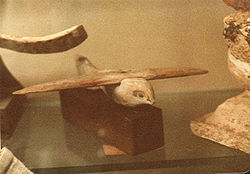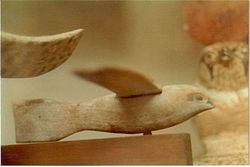- Saqqara Bird
-
The Saqqara Bird is a bird-shaped artifact made of sycamore wood, discovered during the 1898 excavation of the Pa-di-Imen tomb in Saqqara, Egypt. It has been dated to approximately 200 BCE, and is now housed in the Museum of Egyptian Antiquities in Cairo. The Saqqara Bird has a wingspan of 180 mm (7.1 in) and weighs 39.12 g (1.380 oz).[1]. Its function is not understood because of a lack of period documentation.
Contents
Conventional ideas
Some think the Saqqara Bird may be a ceremonial object because the falcon, the bird after which the Saqqara Bird is modeled, is the form most commonly used to represent several of the most important gods of Egyptian mythology, most notably Horus and Ra Horakhty. Others have posited it may have been a toy for an elite child, or that it could have functioned as a weather vane. Some have also speculated it may have been used as a sort of boomerang, as such technology was common and well-known in ancient Egypt in the form of a throwing stick used for hunting waterfowl.[2]
Controversial ideas
Some have suggested that the Saqqara Bird may represent evidence that knowledge of the principles of aviation existed many centuries before such are generally believed to have first been discovered. Egyptian physician, archaeologist, parapsychologist and dowser Khalil Messiha has speculated that the ancient Egyptians developed the first aircraft.[3] He wrote that it "represents a diminutive of an original monoplane still present in Saqqara."[3] He also claimed that the Saqqara Bird could function as a glider if it had a horizontal tailplane, which he "suppose[d] was lost,"[3] and noted that the Egyptians often placed miniaturized representations of their technology in their tombs.[4]
Messiha contended that the Saqqara Bird differs significantly from other statues and models of birds housed in the Cairo museum. According to Messiha, the Saqqara Bird has a vertical tailplane which is unlike the generally horizontal shape of a real bird's tail. It is also legless and has wings set at an angle Messiha sees as similar to that of modern aircraft, which he considered an attempt to create aerodynamic lift.[3]
In spite of these claims, however, no ancient Egyptian aircraft have ever been found, nor has any other evidence suggesting their existence come to light. As a result, the theory that the Saqqara Bird is a model of a flying machine is not accepted by mainstream Egyptologists.
Attempts to prove the claim
Messiha built a model of the Saqqara Bird to test for its aerodynamic efficiency. His model was six times larger than the dimensions of the original in an attempt to maintain its proportional aerodynamic efficiency,[5] and was given a horizontal tailplane to act as a stabilizer, which Messiha believed is a missing part of the original model. Messiha insisted that he was able to make his model fly.[6]
In an attempt to discover whether claims of aerodynamic properties of the Saqqara Bird were correct, Martin Gregorie, a builder and designer of free flight gliders, built a replica of the Saqqara Bird made of balsa wood. After testing this replica, Gregorie concluded: "the Saqqara Bird never flew. It is totally unstable without a tailplane…Even after a tailplane was fitted the glide performance was disappointing."[7] He added: "the Saqqara Bird was probably made as a child's toy or a weather vane."[7]
According to Messiha's son, Dawoud Khalil Messiha, an architect who continued the work of his father, Gregorie's suggestion that the Saqqara Bird could be a weather vane is impossible due to the lack of markings or holes on the model that would serve as a means of hanging it. Dawoud Khalil Messiha noted that the only hole that exists on the bottom of the Saqqara Bird is a recent one and was made by museum officials to fix the model on a stick with reference to a model description in Cairo museum records.[8]
See also
- Pseudoarchaeology
- Experimental archaeology
- Out-of-place artifact
- Egyptology
- Ptolemaic Egypt
References
- ^ Messiha, Dr. Hishmat (1973). Egypt Travel Magazine (Cairo, Arab Republic of Egypt, Ministry of Tourism's Dept. of Publicity) (153). ISSN 0013-2381. OCLC 1567664.
- ^ Larry Orcutt (2001). "Model Airplane?". Catchpenny Mysteries of Ancient Egypt. http://www.catchpenny.org/model.html. Retrieved 2010-04-18.
- ^ a b c d Messiha, Khalil; et al. (1991). "Aeronautics: African Experimental Aeronautics: A 2000-Year Old Model Glider". In Ivan van Sertima. Blacks in Science: Ancient and Modern. Journal of African Civilizations. vol. 5, no. 1-2. New Brunswick: Transaction Books. pp. 92–99. ISBN 0878559418. http://books.google.com/books?id=ea-dgkryq7AC&pg=PA92&lpg=PA92&dq=%E2%80%9CAfrican+Experimental+aeronautics:+A+2000-Year+Old+Model+Glider%E2%80%9D&source=bl&ots=GRQbBdwOKT&sig=RhRwu-XE6gtLDLf8_R22mfgSj_c&hl=en&ei=aJzOS5ahD4S8sgOzkuyuDg&sa=X&oi=book_result&ct=result&resnum=3&ved=0CA8Q6AEwAg#v=onepage&q=%E2%80%9CAfrican%20Experimental%20aeronautics%3A%20A%202000-Year%20Old%20Model%20Glider%E2%80%9D&f=false. Retrieved 2010-04-21.
- ^ Shaw, Ian; Paul T. Nicholson (1995). British Museum Dictionary of Ancient Egypt. London: British museum press. ISBN 0714109827.
- ^ Kermode, A.C. (1960). Flying Without Formulae (Third ed.). London: Sir Isaak Pitman & Sons LTD. ISBN 155857441.
- ^ Fiebag, Peter; Algund Eenboom; Peter Belting (2004) (in German). Die Flugzeuge der Pharaonen. Munchen: Jochen Kopp Verlag. pp. 22–24, 54. ISBN 3930219808.
- ^ a b Martin Gregorie (2002). "Flying the Saqqara Bird". Catchpenny Mysteries of Ancient Egypt. http://www.catchpenny.org/birdtest.html. Retrieved 2010-04-21.
- ^ Journal d' entrée number 6347, Catalogue of Artifacts, Cairo Egyptian Museum.
Categories:- Art of ancient Egypt
- Out-of-place artifacts
- Egyptology
- Pseudoarchaeology
- Pseudoegyptology
Wikimedia Foundation. 2010.


